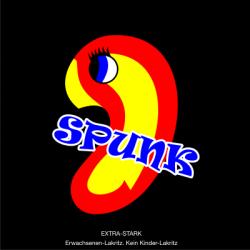These are some designed, fashionable times we’re living in. Everyone seems to be looking their absolute best these days, what with all the haircuts and the shiny clothes and various accessories and trinkets people are decorating themselves with.
It hasn’t always been this way, though. If you browse through photo albums or newspapers from the last century, the first thing you’ll notice is how cheesy and uncool – sometimes plain ugly – everyone looks. But not anymore. Fashion and good looks are here to stay, thanks to the armies of art school graduates, designers and fashionistas that all chose to follow their dreams so they might help the rest of the world look slightly better, slightly more together. This is a good thing, and it should be celebrated.
And celebrate it we will! This March sees a helluva lot of fashion and design related activities swooping over Reykjavík city like a breath of fresh air from the god of style and good taste himself (that would be notable pop singer George Michael). On the surface, all these events indeed seem celebratory in nature, an excuse for the fashion crowd to throw parties, get drunk and pat one another on the back – a stylish pep rally if you will.
But it isn’t that simple. As our series of Q&As with local designers reveals, Icelandic fashion is still in an infant state; a fledgling industry that faces a plethora of problems and adversities, one that is seeking an identity, a purpose and liberation from the shackles of our useless currency system.
Our correspondents from the fashion world – Sruli Recht, Ásta Kristjánsdóttir, Rúnar Ómarsson, Mundi and Bára Hólmgeirsdóttir – are some of the best operating on the island these days. They most graciously agreed to share their time and knowledge to help us try and pin down what Icelandic fashion is, what it wants to be and how it could potentially move things forward to reach wherever it it’s going.
Interview Questions:
1. Describe your operation in as few words as possible. What do you do, what are you about?
2. What are some of the benefits and drawbacks to working your craft out of Iceland?
3. What would you say the world’s perception of Icelandic fashion/design is, if any?
4. At what stage would you say the Icelandic fashion world is right now? Is it able to compete with the outside world?
5. A popular topic these days is fashion and design in relation to environmental concerns, fashion and sustainability. Is it one you take to heart or have given some thought?
6. Assuming you produce artefacts, where are they produced? What are some determining factors in this choice: cost, quality, environmental, local, ethical, worker conditions?
7. How has the ECONOMIC COLLAPSE affected your business? Do you do a lot of export? Have you seen local sales go up?
8. How would you describe your business environment? How would it be, ideally?
9. Given that there is an “Icelandic style”, what is it? What is its philosophy?
10. How do local crowds rate at being stylish?
Sruli Recht. Designer, The Armoury

1. Mine is a small cross-discipline practice caught somewhere between product design, post-tailoring and shoe making. Based in Reykjavík, the studio produces one “non-product” every month, from umbrellas to bullet-proof scarves, tables, to belts and boots, incorporating such materials as concrete, diamonds, skin and wool.
Each non-product has an underlying subtext of irony and the inherent primal darkness hidden in our opaque social relationships.
2. Benefits: Small pool, low level of competition, no predators. Drawbacks: Where to begin… There are no production capabilities on the island. There are small factories with industrial scale production facilities, but the cost of using them is unaffordable due to the monopoly and limitations of the machinery.
There is no migrant labour force or historical knowledge base—labour is therefore sold at the maximum rate. The current system of tax, in the form of astronomical VAT and protectionism import taxes, kneecaps any new business aiming to produce from raw product or import products being produced offshore. This is a formula that means that production here is unaffordable, bringing in material or produced items is taxed at a crippling rate, all making resale with profit near impossible. Then comes the shipping issues… Protectionism and short sightedness are killing the opportunity for growth.
3. The design community has recently banded together as a result of the financial crisis. Before, the handcrafts movement dominated the stage. As it is still very new, the collective output across the different disciplines is still growing. Icelandic design in a global setting is still in its infancy stages.
4. As I said, it is new and growing. It is a very exciting and optimistic time here. Icelanders are financially landlocked due to the fallen Króna—we aren’t able to travel to NY or London and buy a wardrobe. The crisis caused the market to look inward for Icelandic products, which in turn rapidly stimulated the growth of smaller businesses and created a forum for the local market to pay attention to local design. However, the limitations of production make global competition difficult, and as a result demand can often not often be met.
5. When I studied we had a dedicated course every year in ethics and sustainability—it has been imprinted on my design DNA and is a core concern in my practice. A “Non-product” is the name given to the system we use to create products, in a way that directly address an aspect of sustainability. The main point is that my company works in such a way to avoid the bigger challenges, such as the minimum quantities imposed by production facilities and suppliers, and falling into the trap of working with unethical companies to lower costs, or having to over-buy materials from suppliers.
For anything made out of the studio, a special relationship is created with other businesses that are willing to work to the minimum we set. We only make what we need to sell. This is about as conscious your average landlocked business can be and still make a living, short of upcycling [the process of converting waste materials or useless products into new materials or products of better quality or a higher environmental value].
The problem is that ‘Fashion’ itself as a business model is in every way entirely anti-sustainable and that is how it was designed to be. The fashion industry is the biggest pollutant of this world, environmentally and socially. Indigo dye from blue jeans does more damage than any other pollutant. It begins with constantly force-feeding the already overstuffed global market with cheap, replaceable ephemera. The cheaper and more replaceable it is, the quicker it becomes landfill—the core of the problem. An example is printed T-shirts, which are imported, not locally produced, and sold to be worn and replaced. This doesn’t help the growth of the local community, but aids the development of foreign sweatshops.
6. All of the above are factors are relevant. We try making everything in our own studio using as much local resource and material as possible—that is how I can control all of these factors. Cost, on the other hand, is not an issue. My prices reflect the time and quality, and I don’t bargain cost on man-hours.
Design needs to be socially conscious, period. Ethics are the last remaining vestiges of humanity as we cyclically use the sweat and blood of other bodies for our own social profit. The problems used to be in China, are currently in India, and coming next to an Africa near you. We all know what China used to be like, and companies like Nike have all moved out because of the labour unions and better wage conditions… but have you been to India, or do you know anything about it? “Clothing production” in India is “slave labour” by any other name. Even low scale production in India is essentially unethical. At university we studied the global and local effect of offshore production in 1st, 2nd, and 3rd world economies, and this is part of the curriculum for every year we study.
Conscientious design is a core element of design education. Now, it is true that you can’t superimpose a Western capitalist economic mindset on some distant province in China or India—$2 a day for labour there is very different to $2 a day for labour in Los Angeles… But you can make decisions to not aid the culture of sweatshop growth by simply not producing in them. I would dearly, and out of pure curiosity, like to hear the rationalisation of India or Africa as the choice for production in a modern ethical world.
7. It has been great. 98% of what we sell is export. Local sales are as they were.
8. I would describe it as it is now. Ideally it will continue to grow as it is. I really like it in here.
9. Is that a serious question?
10. And this?
Mundi. Artist / Designer, Mundi
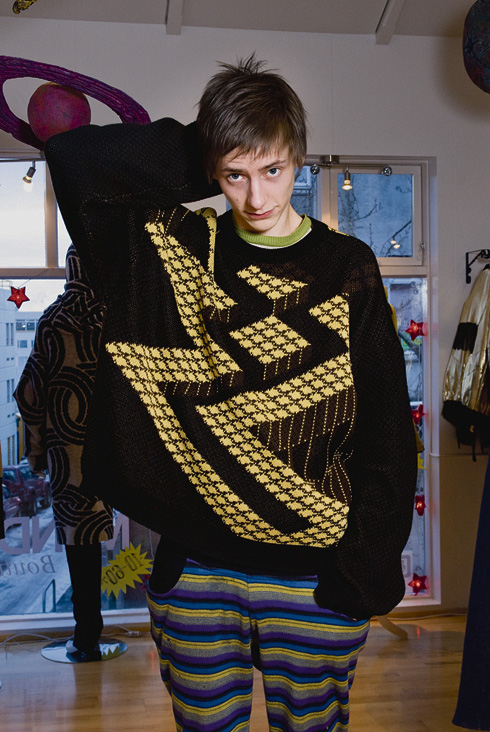
1. My name is Mundi, I am 23 years old and I design clothes and create visual art. The rest pretty much explains itself. I founded the Mundi clothing label around three years ago and I run it to this day. My design is sold in various places all over the world, including here in Reykjavík, where I operate a small boutique on Laugavegur.
2. There aren’t that many benefits, aside from a very positive energy and the ability to achieve inspiration from nature. Fashion consciousness is also on the rise here, and one can count on Icelandic consumers a bit—they’ve supported me a lot. Another positive aspect is that you can produce large-scale events here in a relatively short amount of time —things can happen quickly.
As for the drawbacks: there aren’t any proper clothing factories here, no fashion magazines and one isn’t very connected with the industry. In Iceland, you’re pretty much… on an island. Oh, and the economical situation isn’t anything to celebrate at the moment. On the other hand, there is a lot of interest in Iceland abroad and you sense that being from here is considered pretty cool.
3. I believe it’s good. I’ve learned that there are many trend-spotting companies out there that look to Iceland for inspiration, both our nature and our street fashion. The outside world is very open to Icelandic design. It’s too bad how little support it gets from the state. There is absurdly little state support for the design and fashion industries. It’s as if they’re not exporting goods, which is also absurd if you look at the other Nordic countries, where fashion and design are major export sectors and everyone makes heaps of money. I hope folks start realising that this is a real industry, and there are many open lines to us out there.
4. Ehrm. There are certain local brands that are competitive and have proved themselves as such. 66° North is an excellent outdoors brand, and Nikita is a great snowboarding one. They are both successful in their respective fields. Not a lot has happened in terms of fashion in general, there aren’t many labels going—it’s all so new. Considering the fact that we’re just getting started here, we’re well competitive.
5. I currently am partaking in a project called NICE (Nordic Initiative, Clean and Ethical— nicefashion.org), a Nordic project aimed at actively addressing and tackling these issues in an active manner. It is a worthy cause, as the worldwide fashion industry has a horrible environmental track record.
In my designs, I use a lot of Icelandic wool, which is 100% sustainable, both in handling and colouring. It is furthermore locally produced. It is still very hard to be environmentally sound in the world of fashion, the materials are a lot more expensive and are furthermore often hard to find. But I am aware of these concerns, and I take them to heart. Hopefully, the future holds better things for the fashion industry in this regard.
6. My work is produced in Iceland, France, Turkey and Estonia. At the outset, cost has to be the determining factor. I aim at controlling this facet of my work better, but when you’re getting started everything is so expensive that you need to cut every corner to make it work.
Basically, I consider every one of the factors you mentioned. I even strive to produce locally, even though it’s far too expensive, as I like to support local production and it is also environmentally sound. But at the moment, cost and quality are the main aspects I look towards. Oh, and I heavily oppose sweatshop productions and do not work with those kinds of production plants. Many labels choose to work with ethically questionable factories to cut costs, but I would never.
7. Well, naturally. I’ve undergone a lot of changes since I am fairly new to the business; every year brings its events and changes, and I don’t know whether they can be credited or blamed on the recession or myself. In general, I would say the collapse has had more negative effects on the local fashion industry than positive ones. It is an industry that demands people actively purchasing clothes, and if they can’t afford to, that is a problem.
I’ve been doing pretty well, though. I opened my boutique shortly post-collapse, so I don’t know what the sales figures would have been before it, but the conditions don’t seem to affect me too badly. However, I am not too focused on Iceland at the moment and don’t involve myself too much with it.
8. As I said, I am not too involved with what’s going on here. But if I think about it, I don’t quite understand what’s being done and what the state’s goal is in fostering our working environment, or indeed if they even have one. Are they addressing the problems of this fledgling industry, are they asking questions—what is their motive? Last year, they made some DesignMarch event that I didn’t really understand at all. It seemed like a big waste of money and funding, it presented no solution to the problems at hand and it barely brought any international press or media presence to promote what’s being done here.
So I would like to see more professionalism in regards of the state’s support of these industries. The creative industries in Iceland could also do with a lot more state support and funding. You don’t see any studio complexes for young designers that are starting out fresh out of school—when you graduate from the Iceland Academy of the Arts, you’re pretty much on your own. I’ve fared pretty well in this environment, and I am satisfied with my working conditions, but if I think about the creative world in Iceland as a whole, then a lot is missing. Naming one or two things would be hard.
9. I can’t really say that there is an “Icelandic style”. On the street level, you’ll find every type, from the rocker to the fashionista, but there’s no general identity of Icelandic design or style. Except maybe fulled wool and that sorta crap, which I don’t envision as the future of Icelandic design. Folks need to realise that gambit is pretty much GAME OVER, look to the young designers and see what they’re offering. That Skólavörðustígur-trash isn’t quite pulling it any more.
10. I’d rate them rather highly. There is a lot of attitude in the Icelandic dress code; it’s lively and fun, with big swooping trends and lots of excitement. One thing that’s missing are more guys that are willing to try new things—it’s mainly girls that are dressing up these days. Fashion seems to be a touchy subject among many men, and a lot of them seem to think it’s cool to ignore fashion and dressing well. It doesn’t seem to fit in with the alpha male type.
Rúnar Ómarsson. Founder / General Manager, Nikita
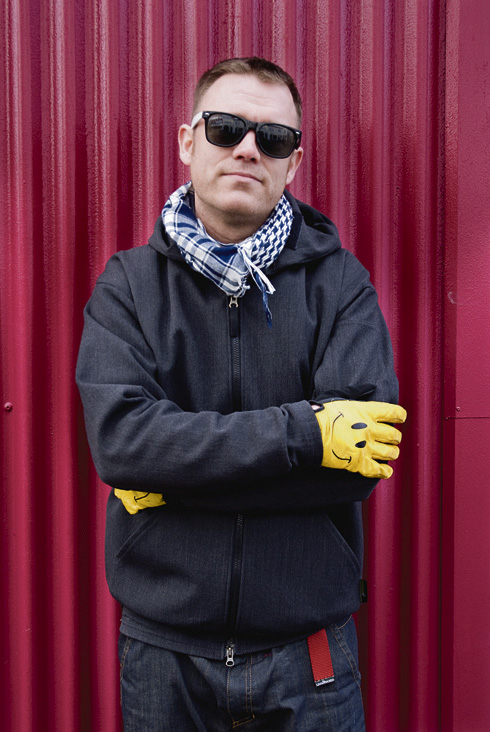
1. Nikita is a 10-year-old Icelandic clothing brand/company. We design and market street fashion and technical outerwear under our brand name.
2. The answer to this question might say more about the person answering than the actual benefits and drawbacks.
The benefits are that we live in a safe, peaceful country with plenty of fresh air and clean water, surrounded by our families and friends. Nothing can replace that. The drawbacks are that the smallness of Iceland prevents new companies from growing and reaching a “healthy” size before trying to break ground in other countries. It is tempting to start flying before you grow wings, and that can lead to a splatter.
Iceland is a pretty good “base camp” for many things, as long as you are able to leave every now and then to escape “The Village People” (other people in Reykjavík), get some sun on your body and into your mind.
3. I’d say the world doesn’t have any perception or knowledge in general about Icelandic fashion. Iceland is a small country in the middle of the ocean, and most people in the world have no clue where it is, nor do they care what we wear. But… Southern Europeans describe the Icelandic style as “Northern European” or “Scandinavian,” the Americans describe it as “fashion forward” and “Scandinavian” if they get deeper into it. Björk is obviously a world famous artist and a global style icon, and as such the biggest reference to Iceland when people think of fashion. Thankfully.
4. The Icelandic fashion world is a toddler, with a craving for strong liquor. I’m not saying that there aren’t creative people here, but as an industry we are one generation behind the other Scandinavian countries in knowledge on product development, marketing, financing of clothing companies and timely deliveries. That being said, there are a few designers/brands/companies that are ready to rumble, and more to come. With events like Reykjavik Fashion Festival we hope to develop talent and distribute knowledge internally, and then spread the word on Icelandic design internationally.
5. Definitely a huge topic and rightfully so. Environmental concerns are a daily topic at Nikita, whether we are working or playing. We have different programs going to make our products and our company more environmentally friendly, and have a special person dedicated to that task.
6. When determining where to manufacture our goods, all the things you mention, cost, quality, environmental, local, ethical and worker conditions are factors. A lot of it has to do with trust. Finding people who you trust to work according to your standards.
7. The economic collapse has for sure affected our business as more or less any and every business. Retailers are sceptical about their future, globally, and that means they pre-book/order less quantities of next season’s fashion. Nikita’s business is over 95% export, so on the other hand the company is getting more Icelandic Krónur for the sales we do in Euro-land. Overall the company is fit and optimistic.
8. Nikita is a part of the international street fashion scene as well as the surf/skate/snow industry. We are lucky enough to work with some of the most fun loving people you can find. Our staff is a bunch of brilliant people. Economy aside, our business environment is ideal.
9. I don’t really think there is anything that we can call “Icelandic style”.
10. 7.5
Bára Hólmgeirsdóttir. Owner / Recyclist, Aftur
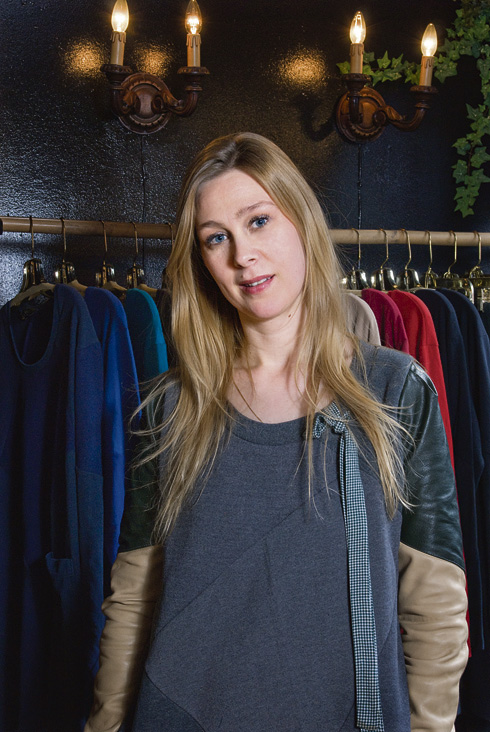
1. Aftur is a ten-year-old company that specializes in recycling old clothing and turning it into modern fashion. In short, we redesign clothing, and our emphasis lies in working locally, being environmentally sustainable and operating an honest business.
2. In my case there are many obvious benefits, as I choose to work locally. The drawbacks are also obvious, and are mostly connected to our currency system. Focusing on the benefits, though, the isolation factors in, as well as the fact that one often benefits from being an Icelander—you can be a big fish in a small pond. Over here you have the network, the language and a general understanding of how things are done. Of course, since I only work locally, I am not prone to the troubles other designers that actively work with factories abroad will experience. I don’t use them, so maybe I am a bit of an anomaly.
3. I believe that pretty much every idea the outside world has about Iceland being cool or fashionable stems directly from Björk. Leave her out of the equation and you’d mostly have people connecting us with Icelandic wool and products made from fish skin. Icelanders are perceived as being somewhat edgy, somewhat cool, which again I think we can directly credit to Björk, Sigur rós and our musicians. We have no history or breakthroughs in the global fashion market, but we do have an edge and some people associate a quality of cool to us.
Be that as it may, the fashion world is built on an old tradition and is a large machine. I think attempts and activities to make Icelanders aware of the industry and its needs are good and well, but staging any sort of Icelandic fashion week at this stage is a little ludicrous. Local promotion is fine, but expecting buyers and the world at large to embrace yet another fashion week is frankly unrealistic—industry buyers can only visit so and so many cities each year. I think that since we are pretty much starting from scratch here, we should rather attempt to link ourselves further to the Copenhagen Fashion Week and Scandinavian fashion in general, instead of attempting to invent the wheel ourselves.
4. No it isn’t competitive with the outside world. We have no factories and produce no fabrics except for wool and skin. Furthermore our currency is very unstable, which cripples the industry even further.
As a whole, I think we are very eager and willing, and that there are many good ideas with lots of potential floating around, but we are still just in the process of taking our first steps on this journey. Fashion design has been taught in this country for a decade now, and in many ways we are a very small, isolated village on the edge of the world. We can’t expect everything we do to be Björk.
5. This is a guiding principle. I am a sustainable fashion designer, and I would think it incredibly cool if Icelanders were to asset their unique position by striving for sustainability and environmentalism in these areas, since we are so small and there is a hip ‘n’ cool element associated with us. Imagine if the few people that are involved with fashion here would come together and agree to an honour code of sustainability, environmentalism, humanitarian and ethical concerns. We could—due to our small size and all our clean energy—set an example for the rest of the world. Not only would our hands be clean of a lot of the foul things that are going on in the industry, it would also serve as an excellent promotional tool and talking point for Icelandic fashion. I believe that those who wish to be successful in this field in the future need to get their act together right now.
6. All of the above concerns are priority issues for us, with localism and environmental conservation being the biggest factors. Our products just cost what they have to cost; we are lucky enough that there are enough people out there that like what we do and are willing to pay a price for it.
7. Well. It’s affected us the same way it’s affected everybody. Dealing with our currency is bothersome, obviously. But I would say that the crash has affected Icelandic fashion designers in a positive way more than anything. In the aftermath that whole “Choose Icelandic” campaign was launched and that brought local shoppers’ attention to us. They’re even feeling protective of the local industries; I’ve had people coming into the store to ask if we’re selling local designs and making their purchases mostly based on that. Long story short: our sales have been up, but the currency is fucked.
8. I am not sure. This is a difficult question. I am very isolated in my workings, just doing my thing here in my studio. I would say my working environment is perfect, really, as I am not in the export business and don’t have to deal with factories abroad or any kind of bureaucracy in that regard.
9. I am not quite sure, but I have given the subject a lot of thought as I get asked this in interviews all the time. There’s something there… Hmmm. There is a core of Icelanders that dresses well and fashionably, but most of them just loll around sporting fleece or black clothing of some sort. The divide is really between 101 Reykjavík and the rest of the country as far as I can tell. There’s something edgy about the 101 crowd, the kids there are original and alert. The rest of us just wear fleece.
10. My locale is 101, I live and work there, and I rate the crowd there as being stylish, hip and cool. But it doesn’t go beyond that really, that small downtown crowd that is fashion conscious.
Ásta Kristjánsdóttir. Founder / Manager, E-Label
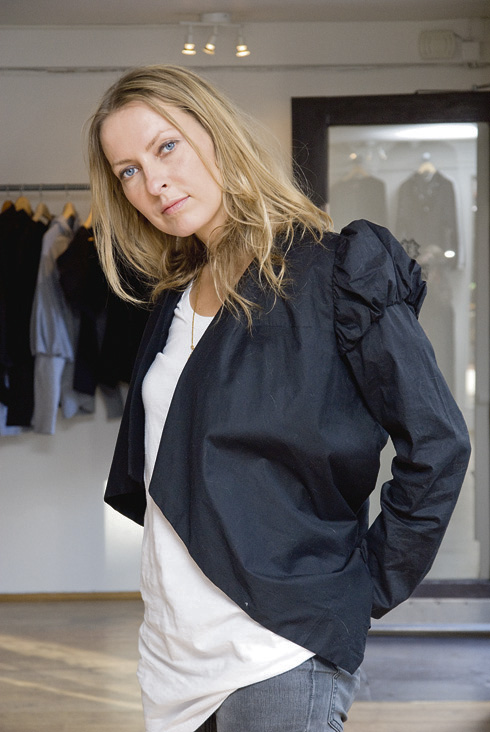
1. E-label has been alive for two and a half years now. We manufacture women’s clothing in India and sell it in the UK and Iceland. I am founder and co-owner of the label, and acting manager.
2. Operating in the Icelandic market right now is very difficult due to the economic situation —manufacturing abroad and paying for it with Icelandic currency has become a very expensive process. The environment is not working with us in that way. Furthermore the government all but ignores our sector and provides few stipends and incentives. Working here sometimes feels like swimming upstream. What’s good about operating in Iceland however is the network you have at your disposal, and the energy stemming from the designers and people. It keeps you alive.
3. I don’t believe we’ve properly made a name for ourselves. And we did suffer a bit of a setback when that whole Iceland Fashion Week debacle hit the international media—that wasn’t very positive for the local industry. Still, the perception is probably neither positive nor negative—it’s mainly lacking. We need more funding to market ourselves internationally, right now it’s important that the Icelandic government realise that putting money into promoting local fashion and design abroad will benefit every Icelander, help create jobs and stimulate export.
4. I would say our industry is at the beginning stages; naturally, some companies have what it takes to make a name internationally while others aren’t quite there yet. But I think that as beginners, we’re doing well, even though we’re just getting started. There is a nice energy, which is indicated by the Reykjavík Fashion Festival.
5. This is obviously something one gives a lot of thought, how one can give back, social responsibilities. We manufacture our products in India and put a lot of emphasis on monitoring the factories to make sure they don’t breach workers’ rights and the like.
We aren’t a huge brand, and thus we cannot afford to buy the most environmentally sound fabrics. Since we are getting good prices in India we decided to give back to the community there, however, and are sponsoring a local women’s empowerment called Saathi, which supports youth living on the street, runaways and homeless women by offering medical services, education and the like. We donate 3% of our profits to the program and are proud of our contributions. We furthermore try and benefit our local community by promoting and selling the creations of young designers that are getting afoot in the business.
6. As I said, we produce everything in a single factory in India that ensures great quality at good prices. I spend around three months per year at that factory and it meets all of my conditions regarding worker safety, working hours and the like. Even though I don’t consider it the nicest place to spend my time, their conditions are acceptable.
7. Sales in Iceland have increased post-collapse, and there is a greater demand for Icelandic design locally. We’ve also been trying to grow our international operations and have placed considerable emphasis on that. To that end, we founded a company abroad as well.
On the downside, being an Icelander right now does not put you in good standing for receiving credit or the like. Which is where our UK branch comes in handy.
8. In short, it’s hardcore. But it’s a great place to get started I suppose—it doesn’t get any harder than this. Yes, the local environment is harsh, but there are upsides. Working with the Króna is always hellish, though, especially if you foster international ambitions.
Ideally we could produce everything at home for affordable prices. Right now, it’s far too expensive. It would also be pretty great if we didn’t have to deal with such high tolls and import fees. In short, a little understanding of this industry and its conditions from the state and powers that be would make a whole lot of difference. And maybe a little support. Oh and having another currency. That would be a dream.
9. The only thing I think is particularly prominent in Icelandic style is its propensity for fads —when something becomes vogue everyone starts wearing it. This has been the case for a long while. Also prominent is Icelanders’ fondness for wearing black, at least women. I think you see more of it here than elsewhere.
10. I’d give them top marks; most people dress pretty nicely and seem to put care into their outfit.
Buy subscriptions, t-shirts and more from our shop right here!
